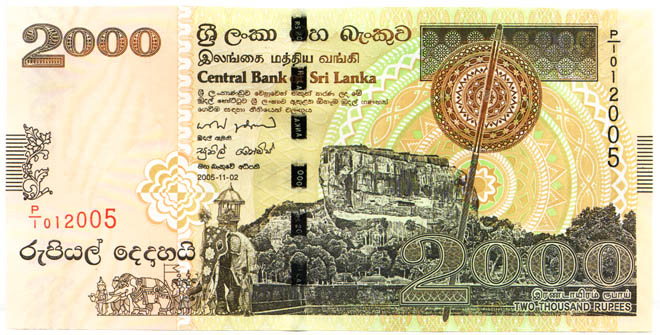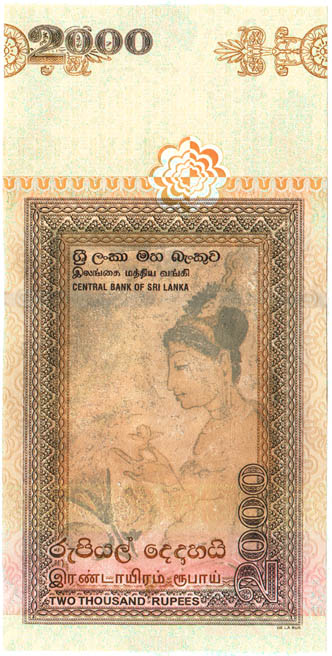

These notes were printed just before the presidential election in 2005, without a final decision to their release and has remained in the Bank vault for almost one year. Normally stocks are held without date and signature, which are printed last when needed.


Dated 2005.11.02, The Rs2000/- note carries the signatures of former Hon. Minister of Finance, Dr Sarath Amunugama and former Governor of the Central Bank of Sri Lanka, Mr Sunil Mendis. The other currency denominations of these two signatures are dated 2004.07.01
The note measures 164 x 82 mm which is 10 mm longer and 4 mm wider than the current Rs1000/- currency note. Bit longer than expected since all of higher denomination notes are 6 mm longer and 4 mm wider than the immediately lower denomination. However being exactly twice as long as it is wide, will stack better.
When the Rs1000 and Rs500 denomination was first issued by CBSL with a date of 1981-01-01 they were about 20 mm longer than the current issued notes of the same denomination and reduced in size with the Heritage series in 1991. The new Rs2000/- will probably just fit inside most wallets without an extra fold on top. The size of all notes would need to be reduced when the next series of currency is issued by CBSL with even higher denominations, with the lowest denomination notes Rs10/-, Rs20/-and maybe the Rs50/- becoming coins.
The serial prefix numbers of the notes start from P/1, 000,001 onwards and appear twice. The number in left hand side of the note is printed horizontally in red while the other is printed vertically in black at the top right hand corner. Both numbers will have asymmetrical fonts, a novel numbering feature first used in the Rs200 polymer note. The P serial letter, same as used on then new Rs1000 note in 1981 is a bit unexpected since the current Heritage Series Rs1000 to Rs10 notes use G H J K L M respectively and the logical prefix should have been F.
The risk of forgery is the major drawback high denomination currency notes. With modern computer technology forgeries of the Rs1000 and Rs500 notes have been made which will go unnoticed by the public in a bundle of notes, although easily identified by closer inspection of the security features. It is the reason for the elaborate designs and intaglio printing on currency notes. The Rs2000 note contains several current and new advanced security features.
The 4 mm. wide STARCHROMETM with 'gaps' on the front of the bank note, while its colour will change from red to green when the note is tilted up and down with clear text showing Rs 2000, butterfly motif and SRI LANKA. Mirror image of this text also appears along the band with the start of sequence and the six broken segments located randomly. A vertical gold band with a repeated lotus motif is printed on the back of the note.
A watermark representing the Heraldic Lion in the National Flag of Sri Lanka with highlighted sword, see through feature. CornerstoneTM a specific watermark feature can be seen as diagonal bars at four corners of the bank note when the note is held up to the light.
Micro lettering 0.25 mm in height with the repeated text banner SRI LANKA CENTRAL BANK in Sinhala, Thamil, and English is printed on both sides.
The fluorescent printing incorporated in this note can be viewed under Ultra-Violet (UV) light. As is standard for this series, the denomination 2000 within box appears to left of the metallic strip. The large dull green and orange circular motif behind the 'Sesatha' glows with a beautiful bright yellow and red.
To assist the visually impaired, twenty tactile bars have been incorporated in front left and right hand center edges of the note that can be rubbed for texture feel. The strengthened corners feel like plastic in the front.
It will probably be a few weeks before the Bank ATM's will issue the new Rs2000 currency note. I understand that some ATM's in Lanka can handle only two types of currency notes. The Rs2000 will as yet be anyway difficult to change in small cash transactions.
In Lanka Cash is used a lot more since Credit Card penetration is not much, and personal checks are hardly accepted by any shop or restaurant. Cash is also probably used for many other reasons and as a consequence there is a urgent need for even higher denomination currency notes to enable large sums to be counted and carried in safety.
The new Rs2000/- note features images from Sigiriya, and is predominantly lighter rose and brown in colour. A topless fresco reappears on the back of currency note since it was used on the back of the Rs100/- notes from 1952 to 1969. The theme and color is same as the Pictorial Rs2/- note first issued in 1941-02-01 with portrait of King George VI. The Pictorial Rs1/- note issued in 1941 featured an Elephant and was green in color matching the current Rs1000/- note.
A gold sovereign was about Rs15 in 1941 and now over Rs15,000. Therefore real value of the Rs2000/= note is also about the same as the Rs2 in 1941. A depreciation of the rupee by a factor of a 1000 in 66 years.
I hope CBSL will follow the theme in the George VI Pictorial series and use the Thuparama Dagoba and the Temple of the Tooth when they design the Rs5000/- and Rs10,000 notes.
The Rs2000 note pre dates the Rs100 note with signature of Mahinda Rajapakse as Hon. Minister of Finance which was issued 5 months ago with the date 2005.11.19.
Author maintains an educational website on two thousand years of Lankan coins at http://coins.lakdiva.org.lk/.